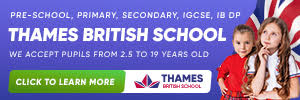On this page:
- Bilingual child
- Why do parents choose a bilingual school?
- Bilingualism in the future
- Bilingual schools in Poland
- Our Kids recommends
Fluency in two languages has obvious advantages in our increasingly globalized world. It’s been shown that, in addition to the practical benefits of being able to communicate with more people, educational opportunities abroad, and better professional prospects, bilingualism has a link to intelligence. This may be due to the fact that learning to use two languages from an early age affects the development of the brain and cognitive abilities.
Bilingual child
Until recently, scientists and educators regarded bilingualism as a kind of obstacle to a child’s natural development. Some part of this claim is true. There’s ample evidence that in the brain of a bilingual child, both language systems are active even when the child only uses one language. In this way, situations can arise where one system blocks the other. However, such interference is increasingly seen as an advantage, as it forces the brain to resolve this internal conflict, thus giving it extraordinary exercise. It’s been proven that bilingual children are often more adept at solving all kinds of intellectual puzzles. We recommend this article: Give your child a solid start in life through bilingualism.
Why do parents choose a bilingual school?
Parents decide to enrol their kids in a bilingual school or preschool for several reasons. One is the desire to improve their linguistic skills from an early age, which later on will provide them with a better start and opportunities for further education. Another relates to the origin of the child. Parents of two nationalities, who are often bilingual, usually want their child to be fluent in both parents’ mother tongues. If they speak to the child in two languages from birth, they’d like to continue this throughout their schooling.
In the past, bilingual schools were quite inaccessible and considered to be elite. Both the tuition fees and the very limited number of places meant only children of diplomats and politicians could attend them. Currently, the popularity of such schools and preschools is growing. In Poland, there are already several dozen institutions (preschools, primary schools, and high schools) that offer learning and daily contact with two languages. These are Polish-English, Polish-Spanish, Polish-French, Polish-German, and even Polish-Japanese schools.
Bilingual schools are often international, meaning they have students from many countries. Such a cultural "mix" helps kids learn together and learn the value of diversity and other traditions and worldviews. Education in bilingual schools isn’t only about learning and mastering a language, but also getting to know other cultures and their traditions.
Bilingualism in the future
Bilingualism in adulthood allows for an easier start in the labour market. People fluent in more than one language, even without much professional experience, have a better chance of getting a desirable job. Graduates of bilingual secondary schools often choose to study abroad—they make global decisions about their future. The language barrier and fear of an unknown environment are a common reason why dreams of further education aren’t fulfilled. Bilingual children don’t have linguistic inhibitions, and they’re more likely to undertake education abroad and learn new languages even more willingly because they’ve had contact with more than one language from an early age.
Bilingual schools in Poland
Parents and guardians who consider sending their kids to bilingual schools no longer have a difficult task. Most Polish cities have facilities that offer education in two languages. Many of them, ranging from preschool to secondary school, admit students all year round. Most of them are private schools.
One of the advantages of private bilingual schools is usually they’re highly comfortable and have modern facilities. The rooms are equipped with the latest multimedia equipment, their libraries are often full of literature in both languages, and they usually offer great sports facilities such as gyms and outdoor sports fields. The tuition fees in private bilingual schools range from several hundred to several thousand zlotys per month. The price depends on the stage of education and location.
Bilingual schools also create classes that can be attended by very young, e.g., one-year-old children, i.e., nursery classes. Their teaching staff is professionally prepared to run an education program for bilingual children—it’s different from the typical learning of a foreign language. During lessons, teachers communicate with students in a foreign language, which resembles learning a language with a native speaker.
The only disadvantage of bilingual education is a financial one. Not every parent can afford this type of school. However, there are so many benefits to bilingualism that it’s a good idea to carefully consider this type of education for your child. Bilingualism is a priceless ticket to an international professional career and an interesting global future.
Our Kids recommends
We encourage you to read this article:
Private bilingual elementary schools in Warsaw
Give your child a solid start in life through bilingualism
People who read this also viewed:
- Educational information
- British A-Level Diploma
- Comparison of the British and American education systems
- Coed schools in Poland
- Schools for boys in Poland
- Schools for girls in Poland
- Schools and classes for children with autism in Poland
- Education for children requiring special support
- Schools and classes for children with ADHD in Poland
- Polish private schools in the second wave of the pandemic (part 1)
- Polish private schools in the second wave of the pandemic (part 2)
- Soft skills
- Students' well-being
- Students' well-being: private schools’ strategies
- School is not just about cramming
- Inquiry-based learning
- Opinions about Our Kids Private School Expo
- The record increase in popularity of private education in Poland
- Third Private School Expo in Warsaw - summary
-
Advice Guide
- ABC of educational terminology: Glossary of terms and concepts
- The admissions process
- Advantages and disadvantages of studying in an international school
- The application process
- Benefits of Polish private schools
- Bilingual schools
- Boarding schools
- Choosing a private or nonpublic school in Poland
- Compare schools in Poland
- English schools in Warsaw
- Homeschooling
- International schools in Kraków
- International schools
- Private school interviews
- Music education
- Myths about private education
- Non-public schools in Poland
- School open houses
- Our Kids Interview: Get to know EF Academy Oxford
- Our Kids Interview: Get to know Open School
- Our Kids interview: Get to know Regent College International Schools
- Our Kids Interview: Get to know The American School of Warsaw
- Our Kids Interview: Get to know The British School Warsaw
- Our Kids Interview: Get to know Wrocław Cosmopolitan School (two interviews, new video)
- Poland school profiles
- Private day schools
- Gifted schools & programs
- Private Jewish schools in Poland
- Language schools
- Private school tuition and costs in Poland
- Private schools in Poland
- Private schools in Poland offering French-language immersion
- English immersion schools
- Poland school uniforms
- Private special needs schools in Warsaw
- Public versus non-public schools in Poland
- Private school questions
- Private school rankings
- Reasons for choosing private schools - Our Kids’s survey report
- Religious schools
- Schools and classes for children with ADHD in Poland
- Social primary schools
- Social Schools
- Special educational needs (SPE) certificates
- Special needs schools
- Study abroad at a private school
- The first annual non-public school fair in Poland
- The first annual Our Kids non-public school expo in Warsaw was a great success
- Third Private School Expo in Warsaw - summary
- Types of schools
- Types of schools in Warsaw
- Warsaw preschool costs
- Why private school?
- Why parents go private
-
Grades
- Boarding high schools
- Choosing a high school in Poland
- Mokotow High School Campus - a new Warsaw high school and Thames British School campus
- Montessori nursery schools
- Montessori preschools
- Our Kids Interview: Get to know English Montessori School Katowice
- Our Kids Interview: Get to know FSA School
- Our Kids Interview: Get to know KIDS & Co.
- Our Kids Interview: Get to know Polish British Academy of Warsaw
- Our Kids Interview: Get to know The English Playhouse and The English Primary
- Poland education: grade levels
- Preschools in Warsaw
- Private & non-public preschools
- Private & non-public primary schools
- Private bilingual elementary schools in Warsaw
- Private high schools
- Private high schools in Warsaw
- Private middle schools
- Nursery schools
- Private primary schools in Warsaw
- Social high schools
-
Locations
- Boarding schools in Warsaw
- English schools in Kraków
- International Baccalaureate (IB) schools in Warsaw
- International schools in Warsaw
- Montessori schools in Warsaw
- Non-public schools in Warsaw
- Our Kids Interview: Get to know EF Academy
- Our Kids interview: Get to know Excellence in Education better
- Our Kids Interview: Get to know PRIMUS Non-Public Primary School No. 47 and Non-Public Secondary School
- Our Kids Interview: Get to know the Canadian School of Warsaw
- Our Kids Interview: Get to know The Primary and Secondary Schools of the Sisters of Nazareth in Warsaw
- Private Catholic and Christian schools in Warsaw
- Private day schools in Warsaw
- Private language schools in Warsaw
- Private schools in Bialystok
- Bydgoszcz schools
- Częstochowa schools
- Private schools in Gdańsk & Gdynia
- Katowice schools
- Private schools in Krakow
- Lublin schools
- Olsztyn schools
- Private schools in Poznań
- Private schools in Rzeszów
- Szczecin schools
- Private schools Warsaw
- Private schools in Wrocław
- Zielona Góra schools
- Private schools in Łódź






 POL
POL CAN
CAN